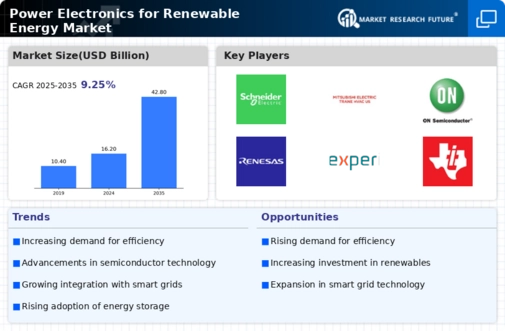Government Policies and Incentives
Government policies and incentives play a crucial role in shaping the Power Electronics for Renewable Energy Market. Many countries have implemented favorable regulations and financial incentives to promote the use of renewable energy technologies. For instance, tax credits, grants, and subsidies for renewable energy projects encourage investments in power electronics solutions that enhance energy efficiency and reliability. As of 2025, numerous nations are expected to increase their renewable energy targets, further stimulating the demand for power electronics. This supportive regulatory environment is likely to foster innovation and competition within the Power Electronics for Renewable Energy Market, leading to the development of more advanced and cost-effective solutions.
Integration of Energy Storage Systems
The integration of energy storage systems is becoming increasingly vital for the Power Electronics for Renewable Energy Market. Energy storage technologies, such as batteries and pumped hydro storage, are essential for addressing the intermittency of renewable energy sources. As the deployment of renewable energy continues to rise, the need for effective energy storage solutions is expected to grow correspondingly. The energy storage market is projected to reach a value of over 200 billion dollars by 2030, highlighting the critical role of power electronics in managing these systems. Efficient power conversion and control technologies are necessary to optimize the performance of energy storage solutions, thereby driving growth in the Power Electronics for Renewable Energy Market.
Rising Energy Demand and Electrification
The rising global energy demand, coupled with the trend towards electrification, is a significant driver for the Power Electronics for Renewable Energy Market. As populations grow and economies develop, the need for reliable and sustainable energy solutions becomes more pressing. The electrification of transportation, heating, and industrial processes is expected to further increase the demand for renewable energy sources. This shift necessitates advanced power electronics to manage and convert energy efficiently. By 2030, it is anticipated that the demand for electricity will increase by 30%, creating substantial opportunities for the Power Electronics for Renewable Energy Market to innovate and expand its offerings.
Technological Innovations in Power Electronics
Technological innovations in power electronics are significantly influencing the Power Electronics for Renewable Energy Market. Advancements in semiconductor technologies, such as wide bandgap materials, are enhancing the efficiency and performance of power electronic devices. These innovations enable higher power densities and improved thermal management, which are essential for the effective integration of renewable energy sources. The market for power electronics is projected to grow at a compound annual growth rate (CAGR) of approximately 10% over the next five years, driven by these technological advancements. As new products and solutions emerge, the Power Electronics for Renewable Energy Market is likely to experience a transformation, with increased focus on smart and efficient energy management systems.
Increasing Adoption of Renewable Energy Sources
The rising emphasis on sustainability and environmental conservation has led to an increasing adoption of renewable energy sources such as solar, wind, and hydroelectric power. This trend is driving the Power Electronics for Renewable Energy Market, as efficient power conversion and management are essential for integrating these energy sources into existing grids. According to recent data, the share of renewables in the energy mix is projected to reach 50% by 2030, necessitating advanced power electronics solutions to handle the variability and intermittency of renewable energy generation. The demand for inverters, converters, and controllers is expected to surge, thereby propelling the growth of the Power Electronics for Renewable Energy Market.


















Leave a Comment